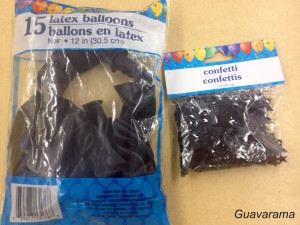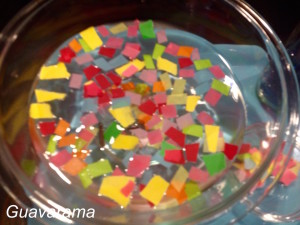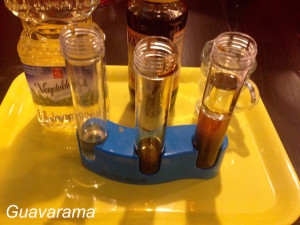Last semester, we started our Science co-op and used Building Foundations of Scientific Understanding (BFSU) as a guide. Because I was the only Montessori mom, and most of the kids were still 5, we ended up doing some lessons like the Long Black Strip from my album, and then more primary level activities like exploring what solids, liquids, and gas is and The Earth’s Rotation
However, by Spring semester, most of the children turned 6. As I was planning our spring curriculum, and contemplating how I keep referring back to the earth’s history for certain lessons, I realized that to reset our Science curriculum, we really need to start from the beginning with the First Great Lesson.
The First Great Lesson is why I like the Montessori science curriculum and really also underlines the philosophy of BFSU. It basically tells the story of the earth’s creation from the Big Bang onward. There are 6 great lessons in all. All of these serves to tie your science curriculum together so that you’re not just studying individual topics. Instead you realize that all scientific knowledge is inter-connected. Children of the Universe is a really great book that talks about all 6 Great Lessons and how/why you present them.
You’re supposed to repeat the once a year, preferably within the first month of school. I’d given the First Great Lesson last year and it was a disaster, with Thumper whining the whole time how she’d heard the story already and it was boring and Astroboy not being able to sit through the lesson or appearing to be interested. I had wondered then, maybe when you homeschool you don’t need to repeat. The children don’t seem to be learning something new at each iteration.
But! I presented it to the children in the co-op this past week and it was such a success. Lesson learned: Lessons are really best when given to 4-6 children.
Here are some pics, with close ups that you can click on.

Material Needed:
This year, I set the presentation up on a table instead of the floor. The 6 things we’re showing the children regarding the creation of the Earth are, from left to right:
- 3 clear cups to show the three states of matter: solid, liquid, gas.
- Bowl of water and shredded paper. Some particles like to cling together, while others repel each other
- Wood to break. You can barely see this
- Jar of marbles to show liquid holds no form
- 3 cups to show how matter change state due to heat: nail or screws, wax, ice cube
- oil, molasses, water to show how some particles are heavier than others
- Volcano, baking soda, vinegar, red food coloring. You can make your own but easier to just buy one.
Presentation:
Here’s a tip: Cover all of the experiments up before you invite the children in. I learned the lesson the hard way the first year. Otherwise they will be staring at that volcano and don’t want to do anything else. We had the children play outside after our morning History co-op and didn’t allow them to come back in till I was done.
My presentation is a combination of Miss Barbara’s First Great Lesson and what’s in my album. Another thing I learned last year is to not try and combine different great lessons together; way too time consuming trying. So all I’m adding is really the balloon element.

We started the presentation by talking about the Big Bang. Waldorf Mama so nicely translated about 1/3 of it and I translated on the fly the other 2/3rd. It was so helpful to have that translation because when I tried to translate last year it was a disaster, feeling like the language was way too hard for the children but not knowing how to modify it without dumbing it down.
Part of the presentation is in the language used and they caution against us modifying it in our album. It may feel a bit too hard but I think with native level kids, around 6-7 is actually a good time to use these words. I also elaborated on the spot a bit when I see blank faces.
起初,宇宙是渾沌的狀態,並且是充滿黑暗的。整個廣大的宇宙沒有所謂的開始,也沒有所謂的結束,也可以說沒有邊界。整個宇宙是一個無法形容的黑暗與寒冷。 當提到『黑暗』兩個字,我們會想到黑夜,但是,我們平日所見的晝夜裡的夜晚對比起宇宙的黑暗,卻有如我們白晝的光亮。 當提到「寒冷」,我們會想到冰。但是,相對於宇宙真正的寒冷,我們所認知的冰,是相對熱的。 然而,在這個無法量測、既黑暗又寒冷的空間裡,光亮被產生了!有一團炙熱且巨大的星雲 (巨大到像是涵蓋了整個天空的星星) 出現。
整個宇宙被包含在那團星雲裡,而我們的世界則是裡面最小最小的星群。但是嚴格說起來,這時根本還沒有任何星星。也可以說,這時除了光和熱,什麼都沒有! 而那熱越來越強烈,以致於所有我們所知道的物質—鐵、金屬、土、岩石、水⋯等,都被「熱」影響到只能以氣體的型態存在於空氣中。所有的那些物質,都被猛烈的光與熱融合在廣大浩瀚的空間裡,那炙熱的程度,足以使今日世界我們的太陽,相較起來像是一塊冰一般。 這一團猛烈又炙熱的虛無星雲,大到無法想像,就這樣進入廣大的極凍宇宙裡。 我們可以想像,上述這猛烈的光熱團,就像比ㄧ滴小水珠,掉進有如汪洋大海的宇宙裡。然而,這滴小水珠卻包含了我們所居住的地球,與所有其它的星體。
At first there was chaos, and complete and utter darkness. The immensity of space had no beginning and no end, and was indescribably dark and cold.
When we think of darkness, we think of night, but our night would be like brilliant sunshine in comparison with that darkness. When we think of cold, we think of ice. But ice is positively hot if you compare it with the coldness of space. In this measureless void of cold and darkness, light was created. There appeared something like a vast fiery cloud which included all the stars that are in the sky. The whole universe was in that cloud, and among the tiniest of stars was our own world. But they were not stars then. No, there was nothing except light and heat. So intense was the heat that all the substances that we know – iron, gold, earth, rocks, water – were gases, as insubstantial as the air. All those substances were fused together into one vast, flaming intensity of light and heat – a heat which would make our sun today feel like a piece of ice. This raging, fiery cloud of nothingness, too huge to imagine, moved in the immensity of freezing space. The fiery mass was no bigger than a drop of water in the ocean of space, but that drop contained the earth and all the stars.
I continued on about the stars in the sky and how they are millions of miles away from each other. Because of that the sun is very far away from us. (And yes, I drew all these Montessori charts which I’m very proud of because Art is my worst subject.) Notice the size of the little Earth as compared with the sun in Chart 1A.

As the particles cooled, they assumed different state. Here I show them Experiment 1, solids, liquids gas. Not too exciting for children because they’re all familiar with it.

Next we talked about how as the particles cooled they started forming solids, liquids, and gas with Experiment 2. I asked the children to drop the pieces of paper into the water and see what happens. I think next time I will use a bigger pan.

Each of these particles were given special likes and dislikes. They formed themselves into different groups.
In the solid state, they cling so close together you need to use force to break them apart. Here I forcibly broke apart the pieces of wood with Experiment 3.
In the liquid state, they hold no shape of their own, taking the space of whatever container they’re in. I roll the jar of marbles around with Experiment 4.

But, they don’t retain their solid or liquid form forever. At a certain temperature, some remain solid, some became liquid, while others became gas. Instead of using a burner or over a stove, I used a match and lit each cup for Experiment 5. I think it’s a bit hard to show the gas state, unless I held the torch and waited till all the water evaporated.

While obeying these laws, the little drops of nothingness was so hot and it went spinning around the sun in the cold space. The particles that were at the outer edge became cold and shrank, they went up to the sky and when they cooled, they came down to the earth where they became hot again. This dance went on for eons. (Chart 3a)
You might be wondering about the angels. I asked why during training and I think my trainer said because it’s supposed to be impressionistic, the whole presentation. You don’t have to give out a lot of facts. The point is to evoke their interest so they want to find out more, not to teach them some knowledge. It is that, plus the fact that Montessori was Catholic.

For hundreds of thousands of years this dance went on. Finally the particles settled down like tired dancers. With the heavier stuff sinking to the bottom. Here I pour the oil and molasses into the water test tube for Experiment 6. It may have been better to have a 4th test tube. But then I would have nothing to hold it.

At last, the earth formed a thin skin. But the hot stuff was still trying to come out. So there were volcanic eruptions with Experiment 7! Look at the make shift volcano we did because I forgot to bring the little cup that hides in the volcano so we had to use the test tube.
This was such a hit, each child wants to do it again and again. I also forgot the red food coloring, otherwise it would have been so cool. Thank goodness Eclectic Mama had some so we eventually added it in.

This also went on for so long and the ashes from the volcano blocked the sun so the earth started cooling down again. (Chart 4a)

At last the earth shrank like the apple that we mummified a few weeks ago, here I show Chart 5a.

Here my presentation kind of petered out. There’s actually a lot more info but by then the kids weren’t really listening because they just wanted to do the volcano. That’s the difference between a presentation in a classroom and our co-op setup. The kids are used to just doing an activity on the spot, whereas in the classroom they’re told the experiments are on the shelf after the presentation. This means that after they were done doing volcanic eruptions for a few hundred more times, the adults had to clean up after them when they ran out to play. The good thing is that there were a few kids who wanted to pour the three different liquids together as well.
All in all, it was a super great presentation, compared with my disastrous first one. I learned that the great thing with a group is that the children can feed off of each other. Maybe with 2 kids once someone doesn’t want to do something, the other person doesn’t either. With 5-6 kids, when one wants to try to pour oil and molasses into water, a few more others want to try it too.
It was so satisfying to watch the oldest in our group, the 9 year old, really enraptured with the presentation. His eyes turned so big and I could tell he was really interested in hearing about the creation of the Earth. I see why teachers like to teach!

